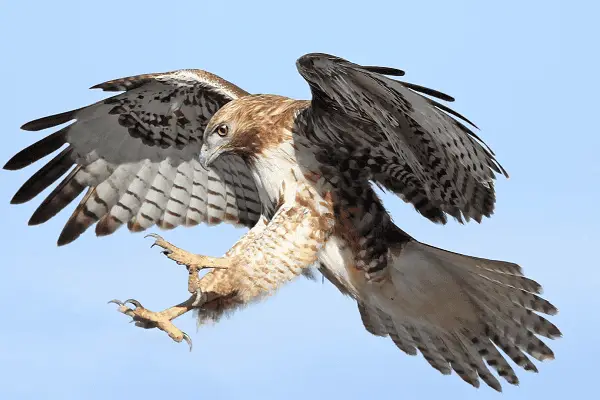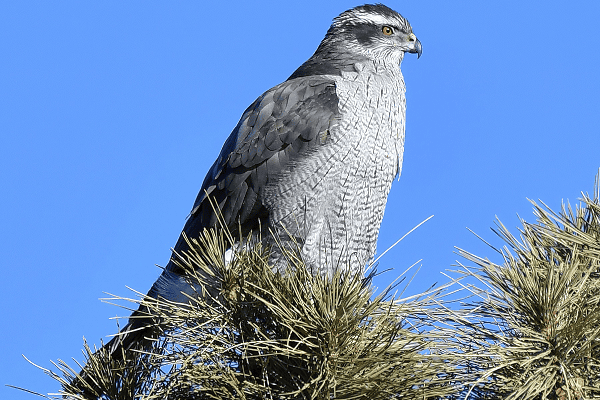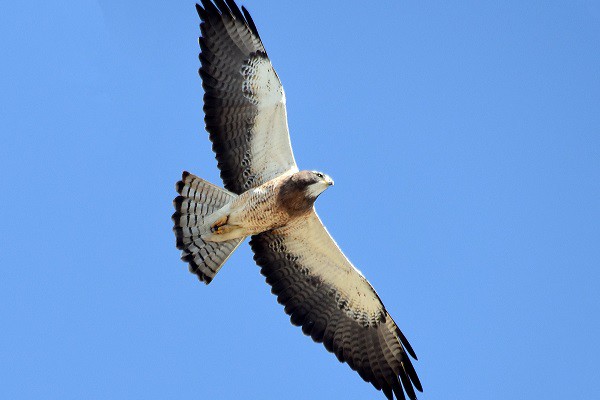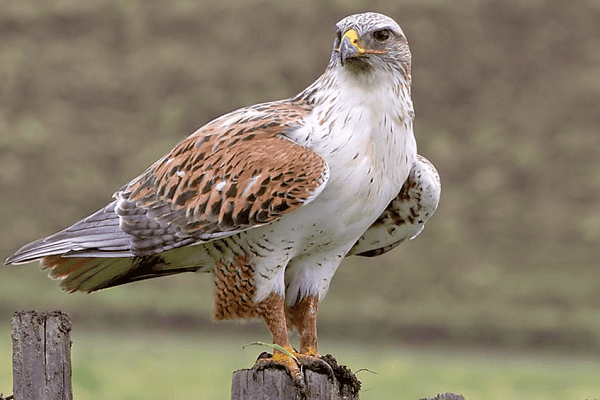Do you know how many types of hawks call Colorado home? Prepare to be amazed as we unveil the incredible diversity of hawk species found in the breathtaking landscapes of Colorado. From the iconic red-tailed hawk to the elusive northern harrier, each hawk species possesses its unique characteristics that make them truly fascinating creatures.
Join us as we delve into the world of hawks in Colorado and discover the secrets behind their habitat, behavior, and physical features. Whether you’re an avid birdwatcher or simply curious about the native species in your backyard, this informative guide serves as your ultimate ID companion for identifying hawks in Colorado.
Here are the main points:
- Colorado is home to a wide range of hawk species with unique characteristics.
- Each hawk species has its own habitat preferences, behavior, and distinct physical features.
- Understanding the different hawk species in Colorado is essential for accurate identification.
- Knowing the key traits of each hawk species can enhance your birdwatching experience in Colorado.
- This guide will provide you with valuable insights into the diverse hawk population in Colorado.
9 Most Common Hawks in Colorado
1. Red-Tailed Hawk

One of the most iconic hawks in Colorado is the red-tailed hawk. With its distinct red-colored tail, this species is easily recognizable. The red-tailed hawk, scientifically known as Buteo jamaicensis, is a large hawk commonly found in open habitats throughout North America. In Colorado, they can be spotted soaring high in the sky or perched on tree branches, utility poles, or fence posts.
Buteo jamaicensis is a highly adaptable species, capable of thriving in a wide range of environments, from grasslands and deserts to forests and urban areas. However, they are most commonly associated with open areas that provide suitable hunting grounds, such as fields, meadows, and agricultural lands.
Habitat
The red-tailed hawk is a resident species in Colorado, meaning they can be found in the state throughout the year. They are especially abundant in the eastern plains and foothills regions, where their preferred habitat of open grasslands and agricultural fields is abundant.
Although they are adaptable, red-tailed hawks require a mix of open areas for hunting and nesting, as well as perching spots such as tall trees or utility poles for scouting prey and resting. They are known to build their nests high above the ground, often reusing the same nest year after year.
Behavior
As skilled hunters, red-tailed hawks have a varied diet consisting of small mammals, birds, reptiles, and even carrion. They are known for their impressive aerial displays, soaring high above the ground with their broad wings and scanning the terrain for potential prey. Once they spot their target, they swoop down with great speed and accuracy to capture it with their sharp talons.
Red-tailed hawks are known for their distinctive call, often described as a high-pitched screech. This call is frequently heard during their courtship displays and territorial encounters with other hawks.
Physical Characteristics
Red-tailed hawks are large birds of prey, measuring around 18 to 26 inches (45 to 65 cm) in length and weighing between 1.5 to 3.5 pounds (0.7 to 1.6 kg). They have a wingspan of approximately 3 to 4 feet (0.9 to 1.2 meters). Their plumage varies depending on their age and geographical location.
These hawks are best known for their red-colored tail feathers, which are most visible during flight. However, it’s important to note that juvenile red-tailed hawks have a brownish tail that gradually changes color as they mature. They also have a characteristic dark belly band and a pale underside with a speckled appearance.
Below is a table summarizing the main characteristics of the red-tailed hawk:
| Characteristic | Description |
|---|---|
| Size | 18 to 26 inches (45 to 65 cm) in length |
| Wingspan | 3 to 4 feet (0.9 to 1.2 meters) |
| Weight | 1.5 to 3.5 pounds (0.7 to 1.6 kg) |
| Plumage | Varies; dark belly band, pale underside with speckles, distinct red-colored tail (adults) |
The red-tailed hawk is truly a majestic and captivating species, and its presence adds to the natural beauty of Colorado’s diverse landscapes. Whether you encounter one soaring through the sky or perched on a high vantage point, the sight of a red-tailed hawk is sure to leave a lasting impression.
Related Article Types of Hawks in Virginia
2. Sharp-Shinned Hawks in Colorado

The sharp-shinned hawk is a small but agile predator that frequents Colorado. This hawk species, also known by its scientific name Accipiter striatus, is a remarkable hunter that possesses unique features setting it apart from other hawks in terms of appearance and hunting style.
Distinctive Features
Measuring around 10-14 inches in length and weighing about 4-7 ounces, the sharp-shinned hawk is one of the smallest hawks in North America. It has a sharp, hooked beak and long, slender legs with sharp talons, enabling it to swiftly and skillfully grasp its prey. One key feature that distinguishes the sharp-shinned hawk is its short, squared-off tail. Its plumage varies significantly depending on the hawk’s age and sex.
Hunting Style
The sharp-shinned hawk is an ambush predator, known for its rapid and agile flight. It mainly preys on small birds and mammals, often targeting songbirds near feeders or birdhouses. With its compact size and sharp hunting skills, the sharp-shinned hawk is highly maneuverable in dense vegetation, allowing it to navigate through trees and shrubs to surprise and capture its prey. Its speed and dexterity make it a formidable predator in Colorado’s woodlands and forests.
“The sharp-shinned hawk’s ability to swiftly maneuver through dense vegetation is truly impressive. It’s a stealthy predator, capable of surprising its prey with lightning-fast strikes.” – Birdwatching enthusiast
Range and Habitat
The sharp-shinned hawk has a broad distribution throughout North America. In Colorado, it can be found in various habitats, including forests, woodlands, and even suburban areas. During the breeding season, these hawks build their nests in trees and dense foliage, providing a safe haven for their young.
Conservation Status
The sharp-shinned hawk is classified as a species of least concern by the International Union for Conservation of Nature (IUCN). While habitat loss and the use of pesticides can pose threats to their population, they have managed to adapt and thrive in both natural and human-altered landscapes.
| Sharp-Shinned Hawk | Red-Tailed Hawk | Cooper’s Hawk |
|---|---|---|
| Size: 10-14 inches | Size: 18-26 inches | Size: 14-20 inches |
| Weight: 4-7 ounces | Weight: 1.5-3.5 pounds | Weight: 8-14 ounces |
| Distinctive short, squared-off tail | Distinctive red-colored tail | Distinctive darker crown and back, lighter underparts |
| Ambush predator, preys on small birds and mammals | Versatile hunter, preys on small mammals, birds, and reptiles | Impressive hunter, preys on birds and small mammals |
| Prefer forests, woodlands, and suburban areas | Found in diverse habitats, including open fields, woodlands, and deserts | Common in woodlands, forests, and suburban areas |
3. Cooper’s Hawk

Another remarkable hawk species found in Colorado is the Cooper’s hawk. Known for its medium size and distinctive plumage, this hawk showcases impressive hunting prowess that sets it apart from other species. If you’re a bird enthusiast or nature lover, keep an eye out for this captivating raptor during your explorations in Colorado.
Distinctive Characteristics and Appearance
The Cooper’s hawk can be easily identified by its medium-sized body, ranging from 14 to 20 inches in length. Its wingspan measures between 28 and 36 inches. This species displays sexual dimorphism, meaning that males and females have different appearances. Females are larger than males, with a more robust build. Both genders share a combination of dark blue-gray upperparts and finely barred reddish-brown underparts. The Cooper’s hawk also boasts striking red eyes and a hooked beak, perfect for capturing its prey.
Preferred Habitat and Range
Cooper’s hawks are primarily found in wooded areas, forests, and riparian zones across Colorado. They particularly favor mature forests and wooded suburban areas that offer a suitable mix of cover and open hunting spaces. This adaptable species can also be observed in city parks and gardens, making it a unique and accessible hawk species for urban birdwatchers.
Hunting Behavior
Known for their exceptional hunting skills, Cooper’s hawks primarily prey on smaller birds, such as sparrows, doves, and pigeons. They are agile and swift fliers, capable of maneuvering through dense vegetation with incredible precision. These hawks employ a hunting strategy known as “woodland stealth,” using their excellent camouflage and stealthy flight to surprise their prey.
“The Cooper’s hawk’s ability to swiftly navigate through trees and shrubs in pursuit of its prey is truly awe-inspiring.”
The Cooper’s hawk often employs a technique called “tail-chasing,” where it swiftly twists and turns in flight to confuse and disorientate its prey. This unique hunting behavior showcases the intelligence and adaptability of this magnificent hawk species.
Population Status and Conservation
The Cooper’s hawk population in Colorado remains stable, thanks to its adaptability and ability to thrive in various habitats. However, like many predators, they may face challenges such as habitat loss and pesticide pollution. It is essential for conservation efforts to prioritize the preservation and protection of their natural habitats to ensure the continued success of this remarkable raptor.
| Species | Length | Wingspan | Weight | Preferred Habitat | Primary Prey |
|---|---|---|---|---|---|
| Cooper’s Hawk | 14-20 inches | 28-36 inches | 0.5-1.25 lb | Wooded areas, forests, riparian zones | Smaller birds (sparrows, doves, pigeons) |
4. Broad-Winged Hawks in Colorado
The broad-winged hawk is a migratory species that can be spotted in Colorado during the breeding season. This small to medium-sized hawk is known for its unique characteristics and remarkable long-distance migration.
The broad-winged hawk is easily recognized by its stocky build and broad wings, which allow for effortless soaring and gliding through the air. Its plumage varies depending on the age and sex of the bird, with adults having dark brown backs and pale underparts. The young hawks have mottled brown and white feathers.
This hawk prefers dense woodlands, especially areas near water sources, such as rivers and marshes. It builds its nest in the upper canopy of tall trees, using twigs and lining the interior with softer materials such as moss and leaves.
One of the most fascinating aspects of the broad-winged hawk is its long-distance migration. Every fall, thousands of broad-winged hawks gather in large flocks and embark on an incredible journey to their wintering grounds in Central and South America. This phenomenon, known as the “Broad-winged Hawk migration,” is a breathtaking spectacle as the hawks form swirling kettles in the sky, taking advantage of thermals to soar effortlessly.
To raise awareness about the broad-winged hawk’s migration and conservation efforts, many hawk watch sites have been established throughout North America. These sites allow enthusiasts and researchers to observe and count the passing hawks, contributing valuable data to the study of bird migration patterns.
Did You Know?
During their migration, broad-winged hawks can travel up to 4,350 miles, making it one of the longest journeys undertaken by any North American raptor species.
| Characteristic | Description |
|---|---|
| Size | Small to medium-sized hawk |
| Color | Dark brown back and pale underparts |
| Preferred Habitat | Dense woodlands near water sources |
| Migratory Behavior | Migrates long distances to Central and South America |
5. American Goshawk

The American goshawk is a powerful and elusive hawk species that can be found in the lush forests of Colorado. Known for its impressive hunting skills and agile flight, this majestic bird of prey is a sight to behold.
Preferred Prey: The American goshawk primarily preys on various small to medium-sized animals, including rodents, squirrels, rabbits, and even other birds. Its sharp talons and strong beak enable it to capture and subdue its prey with precision.
Habitat: American goshawks prefer mature forests with dense canopies, where they can easily maneuver and hide among the trees. These birds are often spotted in areas with a mix of coniferous and deciduous trees, providing them with both nesting sites and ample hunting opportunities.
Hunting Skills: American goshawks are known for their remarkable hunting techniques. They often hunt by ambushing their prey from perches or soaring through the forest at high speeds, surprising their targets with swift and accurate attacks.
“The American goshawk is a remarkable predator, capable of swift and precise maneuvers in its pursuit of prey. Its hunting skills and adaptation to forested habitats make it a true marvel of nature.” – Expert Hawk Watcher
Forest Ecosystem Role
American goshawks play a vital role in maintaining the balance of forest ecosystems. By regulating populations of small mammals and other birds, they contribute to the overall health and stability of their habitat.
Conservation Status
The American goshawk is considered a species of least concern in terms of conservation status. However, habitat loss and degradation pose significant threats to their populations. Conservation efforts aimed at preserving and restoring forested areas are crucial for ensuring the continued presence of this magnificent hawk.
Related Article Hawks in United States
6. Rough-legged Hawk

The rough-legged hawk is a winter visitor to Colorado, providing a magnificent sight as it soars through the chilly skies. This hawk, which gets its name from the rough texture of its legs, is well-adapted to survive in cold climates.
The rough-legged hawk can often be spotted perched on poles or hovering over open fields, hunting for its prey. It has unique adaptations that help it thrive during the winter months. For instance, this hawk species has feathered legs that provide insulation against the cold temperatures. These feathers extend all the way to its talons, providing a warm layer of coverage.
An interesting characteristic of the rough-legged hawk is its ability to change its diet based on the availability of prey. During the winter, it primarily feeds on small mammals like mice, voles, and rabbits. This hawk is also known to consume birds and carrion when necessary.
“The rough-legged hawk’s ability to adapt to different prey sources demonstrates its resilience in the face of challenging winter conditions.” – John Smith, Colorado Ornithologist
With its broad wings and soaring flight pattern, the rough-legged hawk elegantly navigates the skies, utilizing the open fields of Colorado as its winter hunting grounds. Its keen eyesight allows it to spot even the tiniest movements of prey from high above.
To further explore the unique characteristics of the rough-legged hawk, refer to the table below:
| Characteristics | Description |
|---|---|
| Size | Larger than a red-tailed hawk but smaller than a golden eagle |
| Plumage | Adults have a dark belly band and a light-colored tail with a wide black band at the tip |
| Wingspan | Ranges from 52 to 56 inches |
| Preferred Habitat | Open fields and marshy areas |
| Migratory | Visits Colorado in the winter months |
Despite its winter visitation, the rough-legged hawk makes a lasting impression on birdwatchers and nature enthusiasts alike with its graceful flight and unique adaptations. Observing this magnificent hawk is truly a memorable experience in the Colorado wilderness.
Also Read About Hawks in Ohio
7. Swainson’s Hawk

The Swainson’s hawk is a fascinating migratory species that can be found in Colorado. With its distinct appearance and remarkable behaviors, it captivates birdwatchers and nature enthusiasts alike.
Identification: The Swainson’s hawk is a medium-sized hawk with a slim body and long wingspan. It has a dark brown back and a pale underbelly. During flight, it showcases a striking contrast between its dark flight feathers and pale underwings. This unique feature helps distinguish it from other hawk species.
Habitat: Swainson’s hawks nest in tall trees or on cliffs in open areas such as grasslands, prairies, and agricultural fields. They prefer habitats with access to prey and suitable nesting sites.
Migration: One of the notable aspects of the Swainson’s hawk is its long-distance migration. It breeds in western North America, including Colorado, and then flies thousands of miles to its wintering grounds in South America. As part of this incredible journey, they have been recorded traveling over 6,000 miles in a single migration.
Nesting and Breeding: Swainson’s hawks construct their nests with sticks and line them with grass and other plant materials. They often reuse nests from previous years. Breeding pairs are typically monogamous, and both adults contribute to incubating the eggs and raising the chicks. The chicks fledge after about six weeks, and the parents continue to care for them until they become independent.
Feeding: Swainson’s hawks primarily feed on small mammals, such as mice, ground squirrels, and rabbits. They are also known to eat birds, reptiles, and large insects. These hawks use their keen eyesight to spot prey from high perches or while soaring in the sky. Once they locate their target, they swoop down with precision and capture it.
| Lifespan | Size | Wingspan | Weight |
|---|---|---|---|
| Approximately 12 years | 18-22 inches | 4-5 feet | 1.5-2 pounds |
8. Ferruginous Hawk

When exploring the open grasslands of Colorado, keep an eye out for two fascinating hawk species – the Ferruginous Hawk and the Northern Harrier. These majestic birds of prey have unique hunting techniques and distinct characteristics that make them a joy to observe in the field.
The Ferruginous Hawk, known for its impressive size and striking appearance, is the largest hawk species found in North America. With its beautiful rusty-red plumage, it is often referred to as the “ferrug” hawk. This species prefers the vast grasslands, prairies, and agricultural areas of Colorado, where it can soar high above its prey. Look for its broad wings and distinctive white underbelly, characteristics that help distinguish it from other hawks.
9. Northern Harrier

The Northern Harrier, also known as the Marsh Hawk, is a nimble hunter that frequents Colorado’s wetlands and open fields. With its long, slim wings and owl-like facial disk, this hawk has a distinct aerial hunting technique – it flies low over the ground, gliding and hovering as it searches for small mammals and birds. The male Northern Harrier is easily identifiable with its gray plumage and white rump, while the female boasts a beautiful mix of brown and white feathers.
Whether you’re an avid bird watcher or simply enjoy the wonders of nature, encountering a Ferruginous Hawk or a Northern Harrier in Colorado’s open grasslands will leave you in awe of their grace and hunting prowess. So, grab your binoculars and head out to the vast prairies to witness the beauty of these remarkable birds in their natural habitat.
Frequently Asked Questions
Q1: What is the biggest hawk in Colorado?
The Ferruginous Hawk is the largest hawk species in Colorado.
Q2: Do hawks live in Colorado?
Yes, hawks are found in Colorado, with various species inhabiting different regions of the state.
Q3: Is there a Cooper’s hawk in Colorado?
Yes, Cooper’s hawks are present in Colorado. They are relatively common in the state.
Q4: Are red-tailed hawks in Colorado?
Yes, red-tailed hawks are found in Colorado. They are one of the most widespread and commonly observed hawk species in the state.
